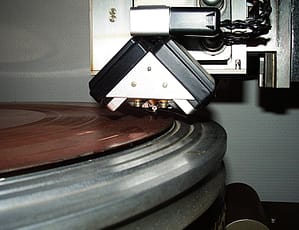An introduction to audio mastering
Not so long ago, professional record productions were reserved for a chosen few artists who had a record label deal. The label would provide the necessary funds, a substantial share back then, since you had to rent several weeks worth of commercial studio time, pay for housing, consumables such as tape, etc. These past few decades, a large part of the production process has been made accessible to virtually every musician. Yet one particular step remains difficult to achieve with just a basic home setup, and this is the mastering stage. In this article I will explain what exactly is mastering, why it matters, and give a few useful tips on how to handle it.
1. What is it and how important is it?
Modern mastering is the very last sage in the production of an album or a song, and it essentially involves the preparation of audio files for public release. There are three main objectives:
- Ensure unity and consistency between the tracks of an album,
- Adjust the tonal balance and loudness to match the sonic quality and codes of the genre concerned,
- Create a master file in a format that is suitable for the required media specifications (digital, CD, vinyl…).
Music is played on a variety of listening devices such as HiFi stereos, bluetooth speakers, car stereo, earphones, computers and whatnot. Apart from the format and encoding technicalities, one important mission of mastering is to allow a consistent reproduction across all these devices. In short, it aims at preserving the original intention of the artist in all situations.
Here is an extract from two versions of a song I mastered, one being the final, un-mastered mix, and the other being the mastered file.
Credits: Blacksheep’s Song by Nikhil Senan
There used to be a lot more (or less, depending on your standpoint) to mastering than what it is today. In the early days of the recording industry, it was purely a mechanical process where a disc cutting lathe was used to engrave a groove into the blank discs. Later the magnetic tape emerged, dramatically improving the audio quality. And in the 1950s mastering engineers started tweaking the audio electronically to enhance the final result, paving the way to modern mastering as we know it.

While mixing often focuses on details and involves shaping individual tracks in order to create a compelling ensemble, mastering involves stepping back and treating the audio as a whole. When a song is mastered by a different engineer than the one who mixed it, you get a fresh set of ears, which is almost impossible to keep when you are working on mixing the song for several continuous hours. This benefit is often overlooked.
Now here is a word about loudness to conclude this first section. The loudness war has made the “volume” topic a hot one, to the point that a lot of people think that mastering is all about getting the highest possible loudness out of a mix. While that might occasionally be the case, digital streaming platforms are now using normalization, which is gradually making the loudness war an obsolete topic. Therefore, most mastering engineers will put their efforts toward sound quality first, not necessarily focusing on loudness that much, especially when they are only mastering for digital media. But we shall get back to the subject later.
2. Mastering is listening
One can only make subtle adjustments when hearing precisely what is going on in a song. That is true when mixing and it becomes even truer when mastering: while mixing can involve pretty dramatic EQ boosts or cuts, mastering rarely involves EQ moves beyond 2 dB. More and more songs are produced in home studios, sometimes in less-than-perfect listening environments. Additionally to the lack of hindsight, mastering a song you’ve mixed in your self-designed home studio is like color-grading while looking through tinted glass.
A room that hasn’t been designed with acoustic transparency from the get-go will have flaws, whatever the quantity of so-called “acoustic” foam panels you throw at the wall. Unless you wish to invest your time and money in a properly treated room with tuned monitoring, it is worth delegating this task to someone whose daily job it is, especially because it often isn’t as expensive as you would expect.
The biggest challenge when dealing with room acoustics in a home studio setup is almost always the low frequencies. For one thing, small rooms create modal resonances and nulls that are difficult to tame because they require thick absorption panels and bass traps, something rarely welcome in a room where space is already scarce. Moreover, home studios are usually equipped with small or medium-sized monitors that can’t reproduce very low frequencies, or use an additional subwoofer which often makes matters worse by amplifying the pre-existing acoustic flaws.
To give you an idea of how flat (or bumpy) your room frequency response is, you can play this audio signal that sweeps the whole spectrum up and down. Be cautious of your volume setting first, because this signal can put a lot of strain on your monitors and your ears. I recommend listening to this with headphones first so you can assess how flat the signal is throughout the spectrum, then compare with how uneven it seems to be when played out in the open on your monitors.
Although using headphones is a great inexpensive way to work around the acoustic flaws of a room, you can hardly rely solely on them because of how un-natural their stereo image is. The “hyped” stereo image on headphones can easily lead to a poor overall stereo width when played back on monitors. When listening to stereo music on a proper monitoring system, your left ear is mainly picking up the left channel. But it is also picking up a blend of the right channel, reaching with a few milliseconds of delay since it has a longer distance to travel, and multiple sound reflections as well, reaching with various delays depending on how far they had to travel or how many times they bounced off walls and objects. With headphones, your left ear receives none of the right channel and very little of the room reverberation. Open-back headphones help in this regard, provided you mute your monitors otherwise you will be picking up some of these nasty room flaws too.
Another important aspect of listening lies in the listener himself: critical listening involves the capacity to switch freely between active and passive listening, and being able to reference what you are listening against the best releases in terms of tonal balance and loudness. This only comes with time and experience, but you can, and you should reference your track against other tracks. Most mixing and mastering engineers have reference playlists. I have several of them by genre, that I have carefully selected not only by picking the best quality mixes or masters but also great songs I have listened to a lot in my life and I know exactly how they should sound whatever the listening environment I am in.
3. Compression
Compression is one of the most common tools used in audio, yet it is one of the most difficult to fully grasp when you’re a beginner. When mastering, it is important to have a very good understanding of how compression works, especially considering that you are compressing the whole song, not just a track or a bus. Compression is different from limiting because they work within a longer time frame, whereas limiters work in a time frame in the millisecond range. Compressors are more musical and limiters are useful to control a volume ceiling. Let’s focus on compressors first.
4. What do you send exactly?
Something missing?
Do you have a question that remains unanswered? Would you like me to expand on something or address a different topic?


